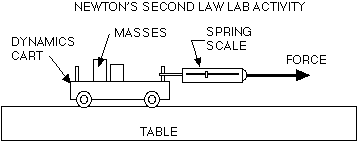Physics 1
Dynamics Lab Activity
Investigating Newton's Second Law
![[Prev]](../../../NavIcons/Prev.GIF)
![[Next]](../../../NavIcons/Next.GIF)
![[Index]](../../../NavIcons/Up.GIF)
![[Home]](../../../NavIcons/Home.GIF)
![[Help]](../../../NavIcons/Help.GIF)
Printer-friendly versions of this lab:
Purpose:
To investigate Newton's Second Law by observing the motion of a
dynamics cart in various situations.
Discussion:
Newton's First Law tells what happens to an object when no
unbalanced forces act on it, and Newton's Second Law tells what
happens to an object when an unbalanced force does act on it
(acceleration = net force/mass). It is one thing to be able to recite
all of this, but quite another thing to understand and apply it to
real situations.
In this activity, you are not going to actually measure
accelerations. As you will see, it is not easy to apply a constant
force to a dynamics cart with a spring scale! Try to think of a way
to apply a constant force to a cart. How could its acceleration be
determined?
Equipment:
|
dynamics cart
|
spring scale
|
long, level table (or floor)
|
|
string
|
set of standard masses
|
Hint: Do not
try to answer these questions in the space provided on this sheet.
Invest in a sheet of paper, please. Also, please use complete
(English) sentences.
Procedure:

Part 1 - Constant Velocity (Dynamic Equilibrium):
- Be sure that the spring scale reads "0 Newtons" when nothing
is hanging from it. You can "zero" it by sliding the scale up or
down.
- Make a loop of string long enough to loop around the end of
the cart and the hook of the spring scale. Be sure that the string
is long enough so that you can read the scale as you pull the cart
across the table or floor.
- Measure the horizontal force required to pull the dynamics
cart across the table at constant velocity. Try a higher (faster)
constant velocity. Do you notice much change in the force required
to move the cart?
- Draw a diagram showing the horizontal forces acting on the
dynamics cart.
- Why is this force necessary to move the cart at constant
velocity?
Part 2 - Acceleration
- Apply a constant horizontal force to the cart greater than the
force you applied in step 1. (Hint: Pull the scale so it reads "1
Newton". As you pull the cart, keep the scale reading 1 Newton.
No, it isn't easy.) What happens?
- What happens if you apply an even larger force (like 2
Newtons)?
- Add mass to the dynamics cart by placing a box of weights on
it. How does this affect the acceleration of the cart when you
apply the same forces that you did in step 1 and 2?
Part 3 - Some Numbers
- A dynamics cart has a mass of about 0.9 kilograms. A friction
force of 1 Newton opposes the motion of the cart and you exert a
horizontal force on the cart of 10 Newtons. The net force on the
cart is ____ Newtons, and it will have an acceleration of ______
meters/second2.
![[Prev]](../../../NavIcons/Prev.GIF)
![[Next]](../../../NavIcons/Next.GIF)
![[Index]](../../../NavIcons/Up.GIF)
![[Home]](../../../NavIcons/Home.GIF)
![[Help]](../../../NavIcons/Help.GIF)
last update December 26, 2005 by JL
Stanbrough